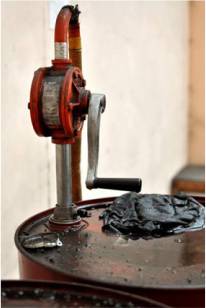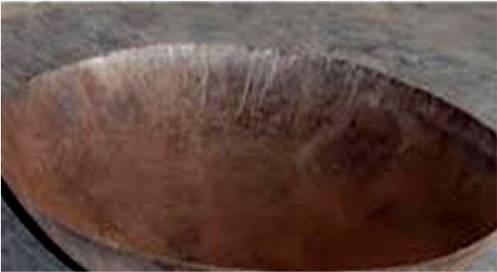You Observe Water in Lubricant Container
 As lubricant professionals (whether manufacturer or a trader), we come across a very common complaint from our clients i.e. presence of water in oil packages.
As lubricant professionals (whether manufacturer or a trader), we come across a very common complaint from our clients i.e. presence of water in oil packages.
Before going into analysis, let me share few of the visit reports in short. It is a mere coincidence that all these examples are for 200 litre drums.
Visit at customer-1 showed us that oil is dispensed from the drum into a mineral water bottle, this is then taken to point of lubrication. No one was willing to vouch for the bottle to be free of water before oil is transferred into it.
Visit at customer-2 showed the oil drum to be stacked in open. We noticed presence of cotton waste on top of drum and we saw rainbow diffraction pattern when sunlight was reflected from top surface. These were enough to hint presence of water on top of drum before being dispensed – must have been cleaned just before our visit.
Visit at customer-3, showed that oil drum was stored in a small warehouse. The drums (with open bungs and a funnel in the bung hole) were lying adjacent to window, which had no panes. Being monsoon season, it was not too difficult to deduce that rain water must have entered the drum through funnel + bung hole.
Visit at customer-4, showed drums stored in open. The drum had few millimeters of water on top of drum. The drums were sealed that is to say that our company seal-cap was intact. But, interestingly, we noticed bubbles escaping from the larger bung from one of the drums. Obviously the water must have gone inside.
 These examples seem to suggest that all mistakes happened only at customer’s end due to their fault. However, this is not the whole story. Let us try to analyze the entire flow:
These examples seem to suggest that all mistakes happened only at customer’s end due to their fault. However, this is not the whole story. Let us try to analyze the entire flow:
-
Upstream: before process happens
-
Process: manufacturing and filling/ packing at factory
-
Downstream: After the goods leave the factory premises.
We had come across an incident which falls under step i) – empty drum is a packaging material supplied by vendor to factory. While regular “incoming inspection” was being carried, water droplets were noticed inside some of the drum. Needless to say, it was rainy season and the drums were kept in open (uncovered) before being dispatched to our factory. After this incident, we had given instruction to the vendor:
-
Bungs to be tightened on drums immediately after manufacturing at vendor’s end.
-
In case it is to be stored, the drums should either be stored in covered warehouse or covered by tarpaulin/ plastic sheet, if stored in open
-
While transporting to our factory the drums should be kept upside down
Step ii) – probability of water entering the product in lube plant is zero. Here it is presumed that the factory is standard one of reputed brand. The usual manufacturing practice involves product being tested by QC before filling. And the filling/ packaging are done through pipeline and pumps etc. Barring unforeseeable circumstances, there is no chance of water entering the product. Also, the warehousing within the factories is usually covered so there is no chance of rainwater finding ingress into the product. We used to organize plant visits especially for big clients and also for clients who complained. They were taken around the plant so that they could be convinced that there was no chance water/ moisture entering into product at factory.
 Step iii), the downstream end is the most susceptible. To start with is the stage of transportation from factory to branch warehouses. There is a possibility of rain water collecting on drum top and entering inside, if the drums are loaded and driven around uncovered. Dry seasons are comparatively safer but rainy season needs precaution.
Step iii), the downstream end is the most susceptible. To start with is the stage of transportation from factory to branch warehouses. There is a possibility of rain water collecting on drum top and entering inside, if the drums are loaded and driven around uncovered. Dry seasons are comparatively safer but rainy season needs precaution.
Same reasoning applies to storage at branch warehouses or customer’s warehouses. If the drums need to be stored in open, then they should be covered by tarpaulin or plastic sheets. If this is also not possible then they should be stored in horizontal position with both bungs in 3o’clock – 9o’clock position.
Last step is dispensing from the drums into point of lubrication. As mentioned earlier casual bottles should be avoided, since its being ‘water-free’ cannot be guaranteed. A customer visit had shown us that even ‘tasla’ was being used for dispensing, which is not a good practice.
There is another very important but often neglected route which we had come across - pilferage. Someone had taken out oil from drum and filled water. It is sad to say that pilferers have the expertise and tools to open the seal cap, remove oil, reseal them and hardly leave any evidence of tampering.
In conclusion, we come to the most important point – what is to be done in case water is noticed in lubricating oil? At customer’s end, it is always advisable not to use such product.
Each manufacturing unit has its own standards or follows the global standard set by its parent company with instruction of disposal or reprocessing of such non-conforming products.
